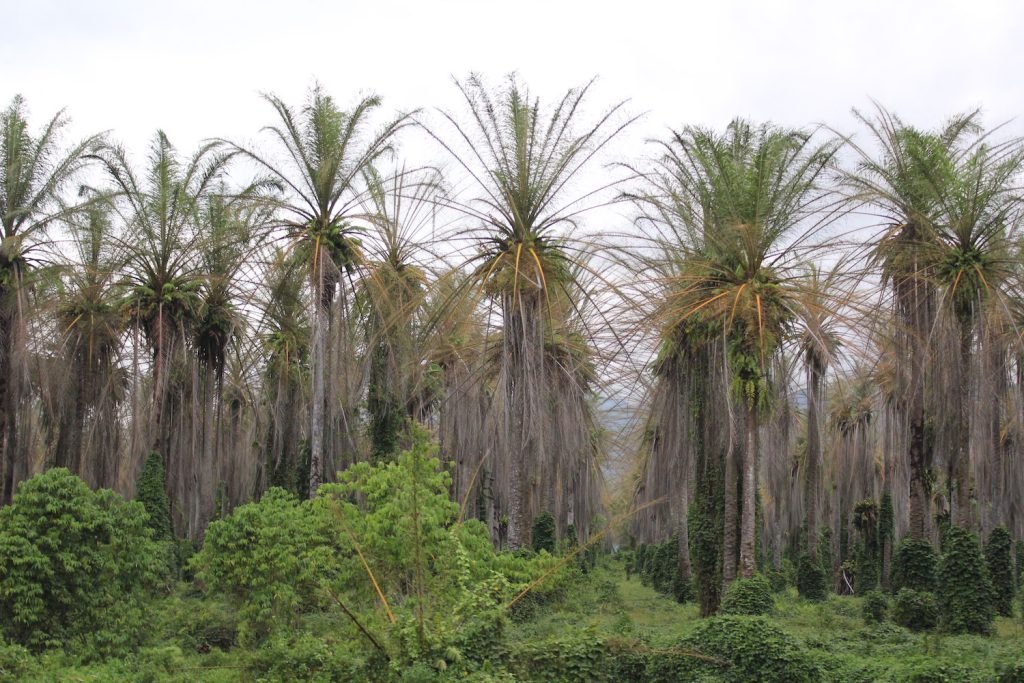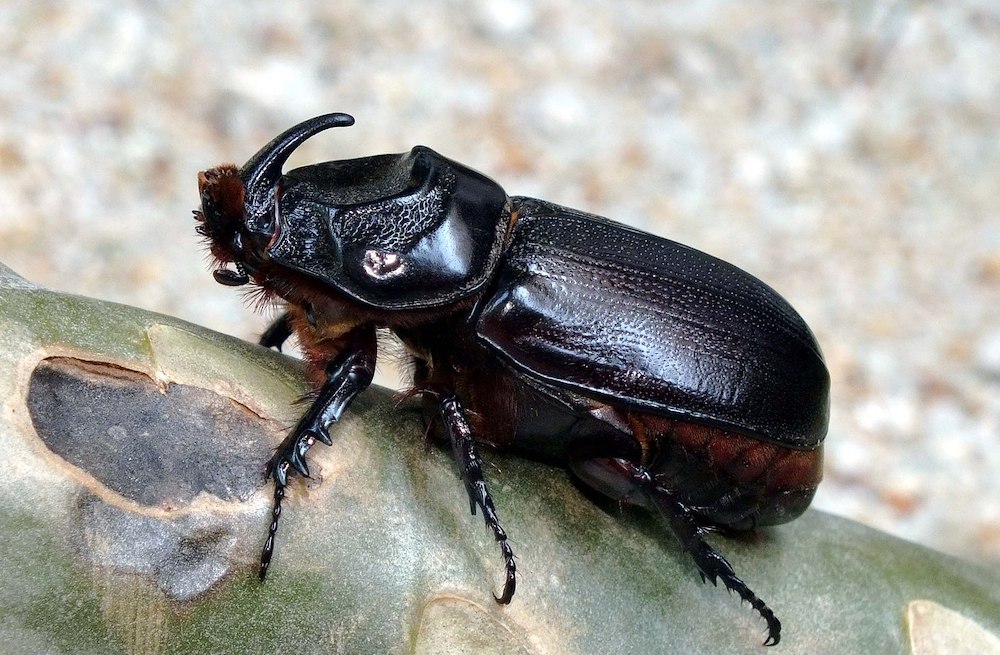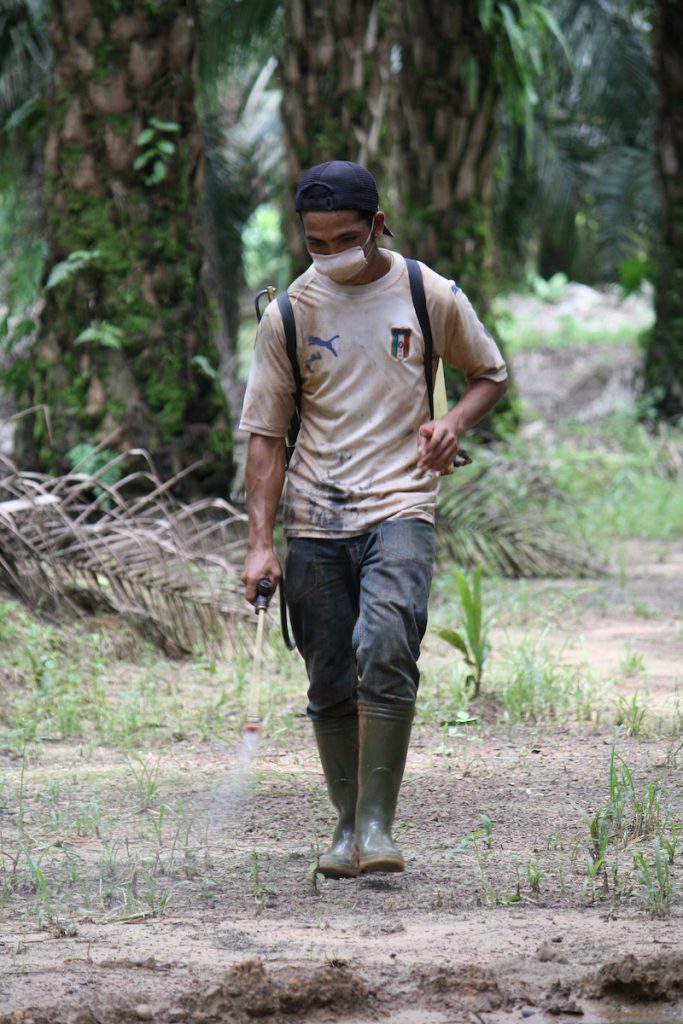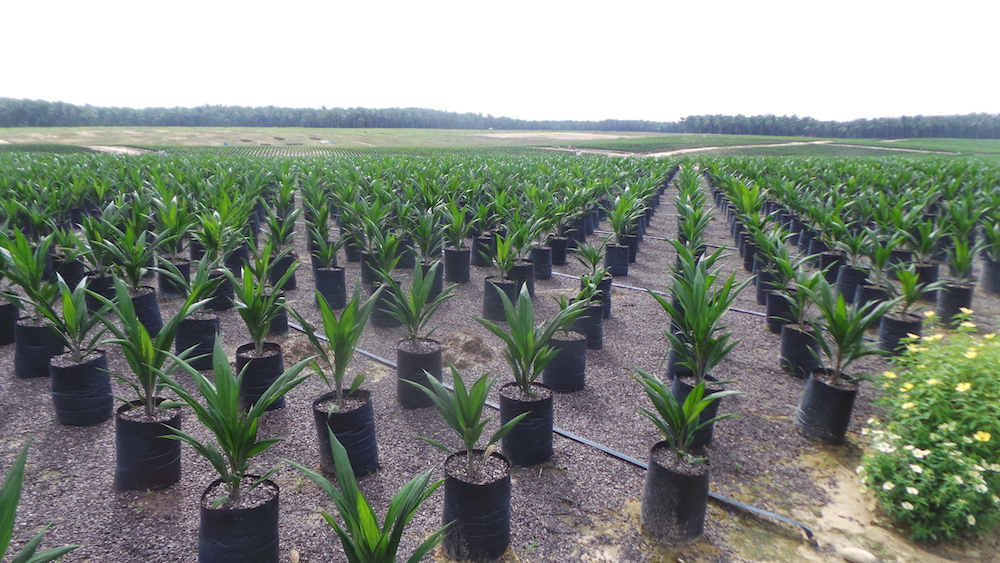Allying With Parasites to Fight Industrial Oil Palm

In October 2019, I traveled through an oil palm monocrop with Marta, my research assistant, and Kosmas, an Indigenous Marind land rights activist from the district of Merauke in the Indonesian-controlled region of West Papua. [1] [1] All names except the author’s have been changed to protect people’s privacy. As we walked down the rows of oil palms, Kosmas pointed out the deep dents in the crown of one of the trees. He explained that rats had nested there and fed their offspring on the palm’s developing fruit bunches.
Rats, Kosmas continued, are one of many animals that prey on oil palm’s fruit, flowers, and fronds. They reproduce rapidly and can bring down hundreds of trees within a few weeks.
Later in our journey, Kosmas identified the traces of other parasites of oil palm in the plantation—the rotting stems of trees where rhinoceros beetles laid their eggs and incubated, the powdery bases of tottering trunks ravaged by a Ganoderma fungus, and the half-eaten fruit bunches devoured by possums and pigs.
When we stopped to rest at midday, Marta, herself an Indigenous Marind woman, expressed surprise that certain species were able to survive in oil palm plantations.
Kosmas smiled and answered, “When people walk through the plantation, they think there is only oil palm. But if you look carefully, you will see that this is not the case.”
We listened attentively, thinking of the many organisms threatened by monocrop expansion—cassowaries, tree kangaroos, and birds of paradise, to name just a few.
“Many Marind see oil palm as the enemy because it destroys our forests,” Kosmas continued. “But oil palm has its own enemies—the beetles, rats, fungi, and many more. Oil palm is taking over the land and forest, but it is not invincible. There is something important to be learned from oil palm’s enemies.”
Industrial plantations, such as the one Marta, Kosmas, and I journeyed through, are premised on the twin logics of simplification and homogenization. These result in the conversion of targeted lands into monocultures dominated by a single cash crop of identical genetic makeup, age, and yield. This makes the plantation easier to manage in terms of planting, harvesting, and pesticide spraying. It produces commodities that are relatively uniform and therefore suited to the demands of processors and manufacturers down the supply chain.
But simplification and homogenization also jeopardize forest biodiversity, threaten endangered wildlife, and undermine ecosystem services such as soil structure and moisture retention. Recent findings in environmental science suggest that oil palm plantations support only, on average, 15 percent of primary forest species, including 23 percent of vertebrates and 31 percent of invertebrates.
These radical ecological transformations are imbued with moral and cultural significance for Indigenous Marind communities, among whom I have been conducting ethnographic fieldwork since 2011. Marind consider forests and their constitutive plants, animals, and elements as sentient, kindred beings with whom they share common descent from ancestral spirits.
In the last decade, however, mass deforestation and plantation expansion have severely undermined the relations of care, respect, and reciprocity underlying Marind’s kinship with forest beings. Oil palm plantations also threaten to diminish the vast and complex body of intergenerationally transmitted knowledges and practices that shape Marind’s everyday activities in the forest, including hunting, fishing, gathering, wayfaring, storytelling, and singing. [2] [2] The following audio file features these field recordings: Clip 1: Marind men prepare for a hunt by imitating the sounds of forest animals; Clip 2: Marind elders sing a genesis song of two plant species they consider as kin; Clip 3: Marind people sing an intergenerationally transmitted sacred song that celebrates the life-giving properties of the sago palm.
These effects, compounded with the adverse impacts of monocrop developments on Marind’s land rights, livelihoods, and subsistence, have brought many Marind like Kosmas to participate in anti–oil palm campaigns at both national and international levels.
And yet, as Kosmas intimated, ecological destruction is only one part of the plantation story. Of particular interest to many Marind activists are those organisms that thrive at the expense of oil palm’s well-being—the parasites, or, in the words of our companion Kosmas, oil palm’s “enemies” (lawan in Indonesian).
While larger mammals and birds, such as kangaroos and cassowaries, struggle to survive in monocrops, other species can live in symbiosis with oil palm. These species may include ants, lichens, wasps, bats, leguminous plants, snakes, and caterpillars. In contrast to endangered wildlife, these oil palm symbiotes—including parasites—are often designated in conservation biology as “background,” “generalist,” “tramp,” “feral,” or “invasive” species.
Parasitism, paradoxically, is a direct consequence of ecological simplification and homogenization. These processes erode the ecosystems that would normally play host to parasites’ natural enemies, and they create the ideal genetic conditions for the proliferation of pathogens. As a result, industrial cash crops such as oil palm are particularly vulnerable to pests and parasites.
In Merauke, common parasites in oil palm monocrops include insects such as the coconut nettle caterpillar, tussock moth, Mahasena corbetti bagworm, and spotted red palm weevil that repurpose oil palms as incubating hosts and sources of food. They encompass fungi of the genera Ganoderma, Fusarium, and Curvularia that proliferate along the trunks and fronds of oil palm trees, causing them to die from diseases such as white stripe disease, brown germ, leafspot, and blast. Pests also include the hordes of wild rats that gnaw at the bases of young palms and devour their fruit, thereby stunting tree growth and threatening the plantation’s productivity and yield.
For villagers like Kosmas who are involved in anti–oil palm advocacy movements, parasites have become a powerful promissory figure and nonhuman ally in the Marind struggle against monocrop expansion. By undermining oil palm’s well-being, these creatures help sabotage capitalist projects that have been initiated by corporations and the government without Marind people’s free, prior, or informed consent.
The resistance of some parasite species to chemical and biological pesticides only enhances their symbolic significance as resilient entities that refuse to bend to the dictates of the agribusiness model. As another anti–oil palm activist, Laurenzius, explained to me, parasites often operate “secretly” and “quietly.” They sprout, multiply, and spread across, above, and underground in ways that are usually invisible to the untrained human eye, until it is too late and uncontrollable epidemics unfold.
In this, Laurenzius added, parasites are like the West Papuan independence movement that is dispersed across the region, has no clear center or origin, and is therefore difficult for the Indonesian government to quash. This independence movement began in the 1960s when West Papua was forcefully incorporated into the Republic of Indonesia. Its members, who are distributed across the region, sustain an ongoing struggle to achieve emancipation from Indonesian rule.
Working away silently but stubbornly at the heart of the agro-industrial system, parasites thus become potent paragons of hope and justice for Marind like Laurenzius, who conceive resistance as the only meaningful path to freedom and self-determination.
Marind activists read in the actions of oil palm’s “enemies” the possibility of multispecies solidarities against monocrop developments and the colonial-capitalist forces undergirding plantation logics. Marind plantation workers, however, are much more conflicted about the meaning of parasites and their own relationship to these species.
Over the last decade, a small but growing number of Marind men and women have taken up employment as sprayers of pesticides in the oil palm sector. The overwhelming majority of these individuals have made this decision less out of choice than out of tacit recognition that oil palm is here to stay and traditional forest-based ways of life are rapidly disappearing.
People who do the spraying eradicate parasites to sustain the well-being of oil palm—the plant that their own livelihoods depend on. But by supporting oil palm and destroying its parasites, these individuals are also siding with the corporations and government driving monocrop expansion and against members of their own communities who are struggling to curb this expansion.
The conflicting relationship of workers to parasites becomes even more complex given their shared exposure to chemicals. In the plantation, laborers inhale or absorb through their skin a range of toxic herbicides and fungicides, including glyphosate, paraquat, glufosinate ammonium, triclopyr, deltamethrin, and trichlorfon. These chemicals also have adverse effects on workers’ own health. Glyphosate (a.k.a. Roundup) and paraquat, for instance, can cause nausea, skin rashes, and breathing problems, and are probable causes of cancer, infertility, and heart attacks.
Workers are opposed to parasites because they make a living from killing them. And yet, ultimately, workers and parasites inhabit the same toxic environment. In the face of shared chemical risks, both humans and nonhumans partake in a strange and deadly form of multispecies solidarity.
The lethal entanglements of oil palm and parasites within monocrops reveal that plantations are neither as uniform nor as controllable as the logic of simplification and homogenization might suggest. Rather, plantations are “emergent ecologies,” where new and different kinds of interspecies relationships are coming into being.
These emergent ecologies can have conflicting implications for the humans caught amid agro-industrial transformations. Parasites, for instance, can embody the promise of multispecies resistance to colonial and capitalist incursions. Or they can speak to the multispecies vulnerabilities that bind humans and nonhumans in the face of plantation expansion and the increased use of agrochemicals.
In each instance, the stakes are high for humans and nonhumans alike: Parasites can signal either the promise of life or death.
By recasting monocrop plantations as multispecies worlds, Marind activists like Kosmas and Laurenzius subvert the notion of “nature” as a passive object of human control—a concept the oil palm industry depends on. Activists’ knowledge of parasites can thus be understood as a form of resistance that undermines the singularizing and homogenizing force of the plantation model.
And in the process, local land defenders draw attention to the shifting horizons of justice offered by interspecies resistance and collaboration for Indigenous people as they strive to reconcile sometimes conflicting aspirations for survival and self-determination.


































